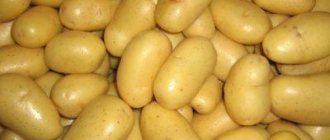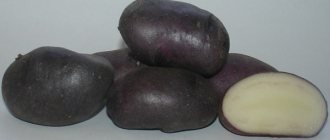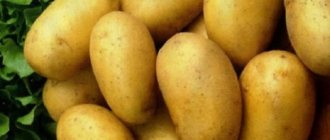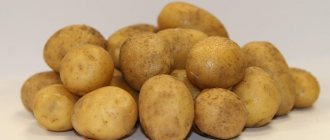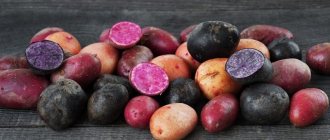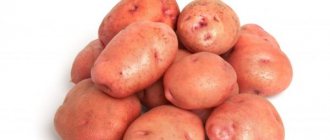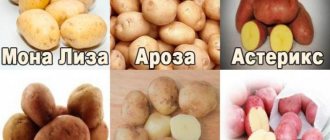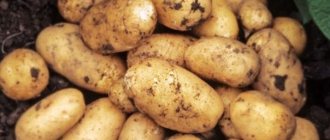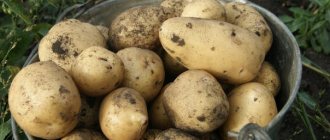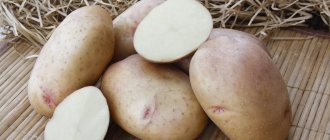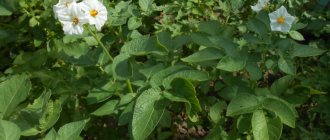Spreading
| Variety name | Tiras |
| general characteristics | early variety with high yield, it is possible to obtain two harvests per season |
| Maturation period | 70-80 days |
| Starch content | 10-15% |
| Weight of marketable tubers | 120-140 gr |
| Number of tubers in a bush | 9-12 |
| Productivity | 210-460 c/ha |
| Consumer qualities | good taste and good cooking ability |
| Keeping quality | 93% |
| Peel color | pink |
| Flesh color | light yellow |
| Preferred Growing Regions | any soil and climate |
| Disease resistance | moderately resistant to late blight, resistant to scab, cancer, nematode |
| Features of cultivation | germination recommended |
| Originator | Institute of Potato Growing NAAS (Ukraine) |
The hybridizer of the variety is the Polesie experimental station of the Institute of Scientific Research of the Ukrainian Academy of Sciences.
The subspecies is grown in the central zone of the country and in the south . "Tiras" grows in the Krasnodar region, Moscow, Yaroslavl, Kostroma, Ivanovo, Vladimir, Ryazan, Kaluga regions. Recommended growing zones: steppe, forest-steppe and woodland.
The subspecies has proven itself well in other countries - in Belarus, Moldova, Kazakhstan, Ukraine. It is often found in the garden plots of amateur gardeners, but is also suitable for farms. Bred for cultivation in open ground. Withstands all weather conditions perfectly. Refers to drought-resistant varieties.
Care
Potato Tiras belongs to an unpretentious subspecies. Thanks to one of its main characteristics, the variety tolerates dry periods well. However, at the stage of active flowering and during the formation of buds, young plants need abundant watering. Lack of water reduces the yield characteristics of the Tiras variety.
Loosening
Before the emergence of shoots, the process of destruction of the earthen coma helps young shoots to break through. Loosening is carried out as necessary, at least 3 times per season. Hard soil causes deformation during tuber formation. It is preferable to perform the procedure early in the morning or in cloudy weather.
Mulching
For mulching, hay, straw, sawdust, peat, and film are used. If there is not enough material, a mixed shelter is made. The average thickness of the mulch layer is 20-25 cm.
Useful characteristics of mulch:
- uniform distribution of moisture;
- slowing down the leaching of the fertile soil layer;
- obstacle to weed growth;
- sheltering seedlings from frost;
- natural fertilizer.
Before using as a soil cover, the material is dried. Damp or fresh mulch impedes ventilation, creating a breeding ground for pathogens.
Hilling
Hilling of young Tiras potatoes begins when the plants reach 15 cm in height. Tubers form on stolons. The greater the length of the underground shoots, the higher the yield. The labor-intensive process protects the root part from overheating, creating favorable conditions for development.
Close proximity to the soil surface gives potatoes a bitter taste. Rolling the tubers down with soil ensures good flavor characteristics of the product.
Characteristics acquired by plants after hilling the Tiras variety:
- a branched, powerful root system is formed;
- the number of green tubers decreases;
- moisture and air are retained in the root zone;
- the plant acquires additional stability.
Potatoes "Tiras": variety description, photo
The bushes are of medium height. They have a large number of leaves. The leaves are elongated, emerald green, with a jagged edge. The flowers are burgundy-lilac. The length of the stolons is 5-6 cm. The depth of the ocelli is miniature.
The number of tubers on one bush is 9-12 pieces . The tubers are uniform in shape. The fruits are oblong, with smooth rounded edges. The surface of the fruit is flat and smooth. The peel has a pink tint. The color of the pulp is snow-white.
The average weight of one fruit is 115-140 g . The starch content reaches 10-15%.
The taste of potatoes largely depends on the amount of starch in its tubers. In the table below you can see what this indicator is for different varieties:
| Variety name | Starch content |
| Tiras | 10-15% |
| Cast iron | 12-15% |
| Svitanok Kyiv | 18-19% |
| Sheri | 11-15% |
| Artemis | 13-16% |
| Tuscany | 12-14% |
| Yanka | 13-18% |
| Purple Haze | 14-17% |
| Openwork | 14-16% |
| Desiree | 13-21% |
| Santana | 13-17% |
For a more accurate idea of what the Tiras potato variety is, the characteristics are not enough. Take a look at the photo:
Characteristics of tubers
Tiras potatoes are different:
- oval, slightly elongated shape;
- smooth and even skin;
- the presence of a large number of shallow ocelli;
- pink tint of the peel;
- light pulp with a barely noticeable yellow tone;
- good cooking ability;
- fairly high starch content - up to 15%;
- excellent keeping quality – 93-94%.
Tiras potatoes have excellent taste, which directly depends on the percentage of starch. The table below presents a comparative description of varieties with the highest starchy values.
As you can see, Tiras is one of those varieties whose tubers are best suited for use for culinary purposes: frying, boiling, baking, and so on.
Productivity
Let's consider the yield characteristics of the Tiras potato. The variety is suitable for obtaining two harvests. Belongs to mid-early varieties.
From the emergence of seedlings to technical ripeness, 70-80 days pass. In the coldest regions, the variety ripens in 90 days. The growing season lasts 60-65 days. Fruit formation occurs 10-15 days after planting.
The harvest is harvested 38-42 days after the first shoots . 210 centners of fruits are harvested from 1 hectare. At the end of the growing season, the total yield reaches 460 centners per hectare.
The yield of marketable tubers is 93%. The variety has excellent keeping quality. It can be stored in cool vegetable stores for more than 5 months. Has a table purpose. Taste qualities are rated 3.7-4.0 points out of 5 .
Read more about the storage time and temperature of potatoes, and about possible problems. And also about storing it in winter, in boxes, on the balcony, in the refrigerator, cleaned.
You can compare the yield and keeping quality of a variety with others using the table below:
| Variety name | Productivity (c/ha) | Keeping quality(%) |
| Tiras | 210-460 | 93 |
| Serpanok | 170-215 | 94 |
| Elmundo | 250-345 | 97 |
| Milena | 450-600 | 95 |
| League | 210-360 | 93 |
| Vector | 670 | 95 |
| Mozart | 200-330 | 92 |
| Sifra | 180-400 | 94 |
| Queen Anne | 390-460 | 92 |
The variety is responsive to fertilizing. Read more about how to fertilize potatoes, when and how to fertilize, and how to do it correctly when planting.
It is recommended to remove the tops two weeks before harvest. It is harvested from both seed and food bushes. This procedure accelerates the ripening of fruits. This method also prevents the re-infection of viral diseases by carriers.
Peculiarities
The characteristic features of the Tiras variety include:
- Early ripening. The growing season ranges from 55 to 65 days;
- Productivity varies from 210 to 460 centners per hectare;
- Pre-sowing germination of seed material is recommended;
- Taste characteristics on a five-point scale are rated at 3.5 points;
- Ideally aligned root crops form quickly;
- When grown in the southern regions, two harvests are obtained per season.
Landing
Agricultural technology is standard. Planting must be done in the first ten days of May . Plots of land are chosen that are well lit. Recommended planting pattern: 35x60 cm. Sowing depth should not be more than 8-10 cm.
Potatoes should be placed after annual or perennial grasses, winter crops, grains or legumes. The variety grows actively on all types of soil .
Before planting, all sprouts on tubers must be broken off . Otherwise, additional stems will not sprout from the eyes. The plant may be skinny, with a small number of leaves and subsequently with a poor harvest.
Reviews about the variety
Many experienced potato growers and amateur vegetable growers characterize the Tiras potato variety as an excellent competitive variety that produces a large harvest of beautiful root crops. The plant has very beautiful blooms. Caring for the variety is quite simple: feed it with fertilizers, fight weeds, and also hill up potato plantings.
Potatoes "Tiras" are early ripening varieties. Immune to various diseases. Loose, breathable soil is suitable for growing. Root crops are well stored for a long time and transported over long distances.
Potatoes are a source of ascorbic acid, vitamins B1, B, beta-carotene, phosphorus and other microelements. Nutritionists strongly recommend including it in your diet without fear of extra pounds: with moderate and balanced consumption they will not appear.
Among the whole variety of varieties and hybrids, a variety from Ukrainian breeders called Tiras takes pride of place. The culture surprises with its high productivity and large tubers, suitable for growing for sale and for personal consumption.
Growing
Prefers systematic watering no more than once a week. Does not tolerate waterlogging of the soil in the second decade of the growing season.
Water causes fruit to rot . Under such conditions, the root system is not able to develop stably. Rot may appear on the plant. The variety requires loose soil, which means hilling is required.
In rocky soil, potato tubers may be deformed. It is necessary to remove weeds periodically. You can mulch areas. Weeds draw out essential minerals. Bushes overgrown with weeds bring a reduced yield.
Read about how to grow potatoes without weeding and hilling here.
When growing potatoes, additional chemicals are often used to improve yields or control pests. Read all about the benefits and harms of fungicides, herbicides and insecticides in useful articles on our website.
Diseases and pests
Potato variety "Tiras":
- Immune to potato cancer, root crop rust;
- It has average resistance to stem nematode and common scab.
Among the pests, mole crickets pose a danger to potatoes. Pest control methods:
- In case of a mass invasion, a 10% karbofos preparation is used: 50 grams of the mixture is diluted in a bucket of water at room temperature;
- With a small number of pests, the use of the traditional method is effective. Boil legumes and grains, add vegetable oil and water. The prepared solution is used to spray the plantings;
- In the fight against the Colorado potato beetle and its larvae, chemicals or traditional methods are used.
How to grow potatoes on the plot
The culture is absolutely undemanding to the type of soil and grows in many regions of Russia - even in areas poor in nutritional components. Potatoes perform well in regions with hot and dry climates.
Read also: How many calories are in dried pumpkin seeds
The variety's agricultural technology is simple, it does not require a special approach, but to harvest an excellent quality harvest, it is recommended to adhere to certain rules. Care involves moderate watering, loosening, hilling and weeding of beds, fertilizing and preventive treatments against pests and diseases.
Dates, scheme and rules of planting
Seed material for planting is prepared in the fall. Select medium-sized tubers, without damage or signs of rotting. In the spring, the seeds are re-sorted and taken out of the basement into a bright room with an air temperature of +14-15°C, laid out on a flat surface for germination. The procedure is carried out 20-25 days before planting. During this period, sprouts will appear on the tubers.
To prevent the development of infectious diseases, seeds are disinfected in a pink solution of potassium permanganate, Fitosporin or copper sulfate.
Before planting, the area is sown with wheat, lupine, rye, flax, mustard, and a month later it is mowed and buried in the ground. Green manure plants replenish nutritional deficiencies and prevent the growth of fungi and bacteria.
Planting is carried out in early May in soil warmed to a temperature of at least +6°C. Pits are formed on the site with a depth of 8-10 cm, with an interval of 30-35 cm. 150-200 g of ash and 30 g of superphosphate are poured into each. The row spacing is 65-70 cm. Large tubers are cut into two parts, treating the cut with ash.
Basic agricultural techniques are as follows:
- Maintaining crop rotation. It is not recommended to grow the crop for several years in a row in one place. It is optimal to use beds where cabbage, beans, and peas previously grew and not to plant potatoes next to tomatoes due to common diseases and pests.
- Moderate watering. The best way to control moisture levels is to install a drip system. When watering manually, weather conditions are taken into account: at moderate air temperatures, once a week is enough; during periods of drought, the frequency is increased to 2-3 times. It is important not to overwater the bushes, otherwise the tubers will be too watery and lose their taste.
- Loosening. The procedure is carried out after each watering, preventing the formation of a hard earthen crust.
- Hilling. An important rule for caring for potatoes, which allows you to simultaneously remove weeds and saturate the root system with oxygen. The bushes are earthed up for the first time 2-3 weeks after planting, and again after flowering.
- Harrowing. The procedure is carried out on areas exceeding three hundred square meters. A harrow is mounted on a tractor or walk-behind tractor, the teeth of which pull weeds out of the soil and deeply loosen the soil.
- Fertilizer. The Tiras variety is not too undemanding in terms of soil composition, but at the same time responds positively to organic and mineral fertilizing, increasing productivity. Before planting, a solution of chicken manure is added to the soil (1 tablespoon of dry chicken manure per 10 liters of water); after flowering, the bushes are treated with foliar fertilizers (2 g of sodium humate per 10 liters, 200 g of urea, 10 g of boric acid per 10 liters) .
Reference. Potatoes have one peculiarity - they absorb only 50% of the substances from root fertilizers and actively absorb minerals when spraying greens.
Nuances of cultivation and possible difficulties
Difficulties when growing Tiras potatoes rarely arise even for beginners. To increase productivity and protect tubers from degeneration, which is typical for many crops propagated by vegetation, experienced farmers recommend purchasing seeds from trusted sellers and promptly replacing the material.
The variety shows the same productivity both with traditional growing technology and with proprietary cultivation methods.
Igor Lyadov’s method involves planting tubers in closed beds and saves a lot of time and effort on care. Boxes with earth are installed on the site in the direction from north to south. Wooden sticks, boards, and bricks are used for production. The height of the sides is 20 cm, width - 1.1 m. The bottom is lined with straw, grass, hay, dry leaves, cardboard or paper. Compost mixed with soil is placed on top.
Before planting, the soil is loosened, holes are formed in two rows 10-15 cm deep and with an interval of 30-40 cm. Next, holes are made at a distance of 0.3-0.4 m. The tubers are planted in a checkerboard pattern, sprinkled with ash and crushed eggshells on top and covered with soil. After the bushes appear, they are weeded and the beds are mulched with straw. Further care does not differ from traditional care.
Read also: How to put a rubber seal on a refrigerator
Diseases and pests
The crop is characterized by average resistance to late blight of tops and tubers, and is immune to common scab, cancer, nematode and leaf curl virus.
Symptoms of late blight:
- dark and curled leaves;
- white coating on the reverse side;
- dark spots on potatoes.
Preventive measures:
- crop rotation;
- maintaining gaps between bushes;
- selection of a site on the south side;
- soaking tubers with “Immunocytophyte” before planting;
- harvesting potatoes in dry and sunny weather;
- fertilizing with potassium and phosphorus;
- soil nitrogen control;
- treatment of bushes with a 1% solution of Bordeaux mixture, copper sulfate (20 g/10 l), Silk or Krezacin.
Treatment:
- before flowering - treatment with Ridomil Gold MC, Oxyx (twice every 10 days);
- after flowering - treatment with Bravo every 10 days;
- before harvesting - a single spraying with the drug "Alyufit".
The following methods are effective against the Colorado potato beetle:
- Treatment with birch ash in the morning on leaves damp from dew or rain (10 kg per 100 sq. m). Larvae and adults die after 48 hours.
- Infusion of white acacia bark. Pour 1 kg of dry raw material into 10 liters of water, leave for 3-4 days, strain and process the bushes.
- Celandine. Fill a 10 liter bucket halfway with fresh herbs, add water and place on low heat. Boil for 20 minutes, cool and dilute with water 1:20.
- Dandelion. 200 g of dandelion greens along with flowers, 200 g of horsetail, pour 10 liters of water, boil for 20 minutes, cool and dilute with water in a ratio of 1:5.
